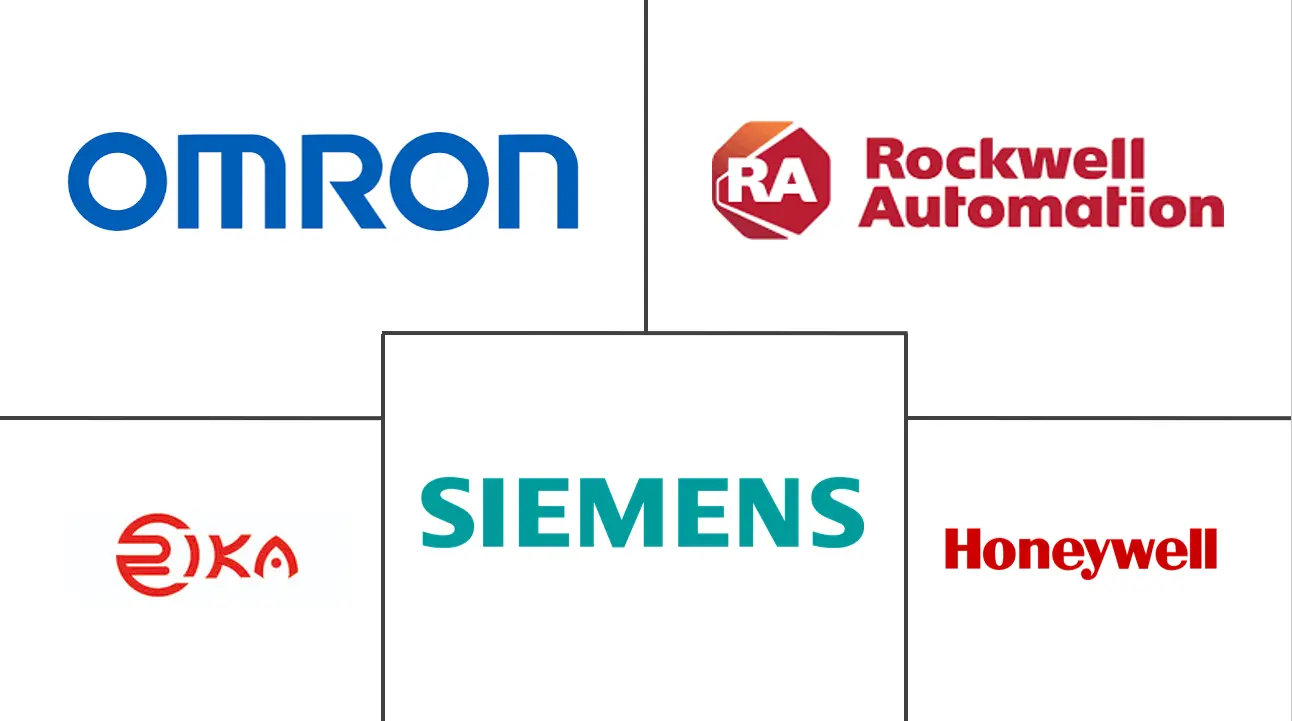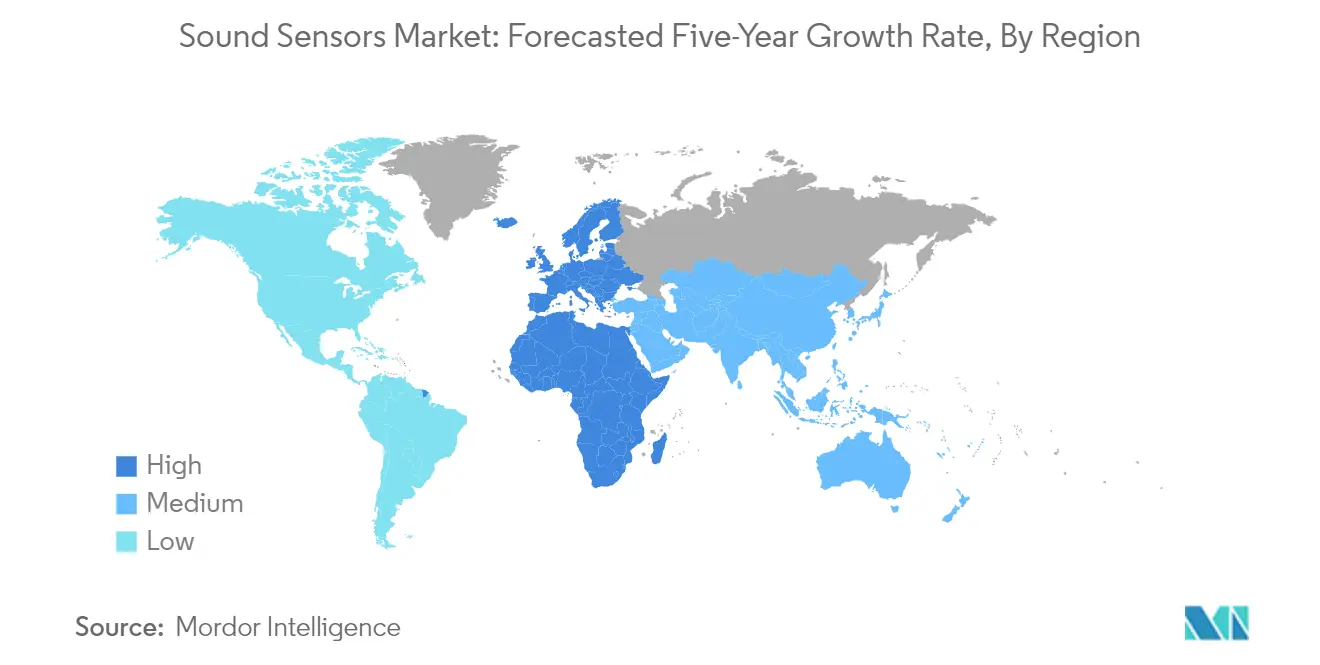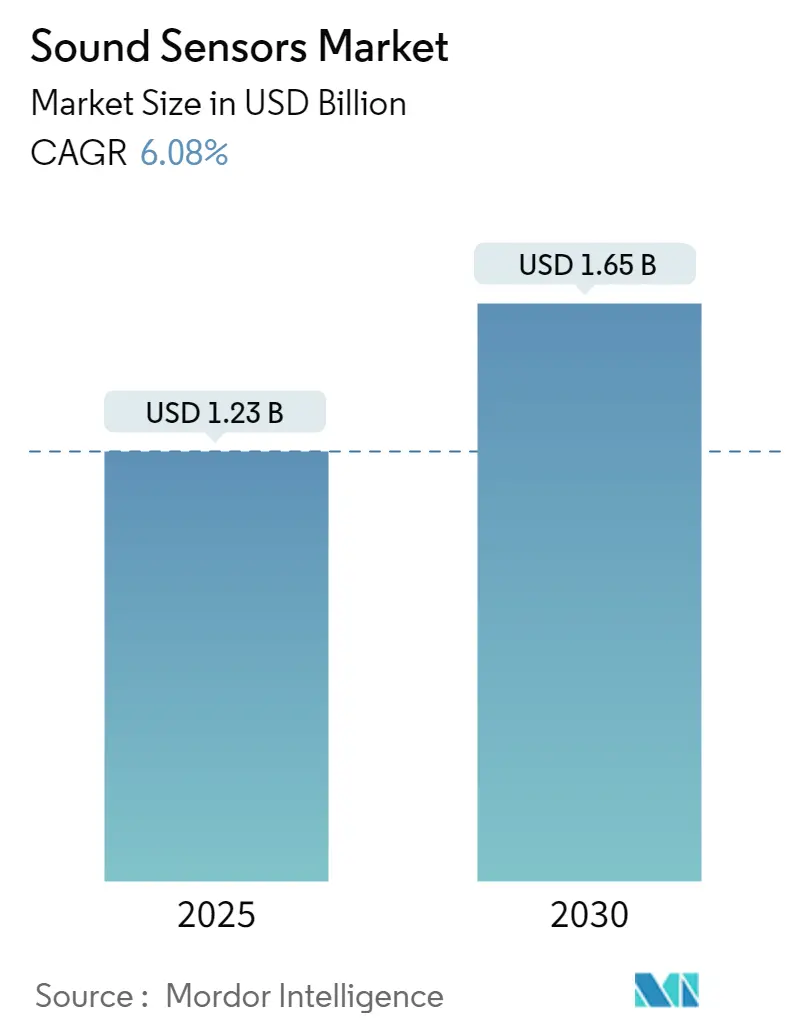
Sound Sensors Market Analysis
The Sound Sensors Market size is estimated at USD 1.23 billion in 2025, and is expected to reach USD 1.65 billion by 2030, at a CAGR of 6.08% during the forecast period (2025-2030).
The sound sensors industry is experiencing significant transformation driven by the rapid advancement of Industry 4.0 and industrial automation. According to recent industry data, over 65% of German companies have already implemented Industry 4.0 practices, with another 25% planning to follow suit. The integration of acoustic sensors in manufacturing processes has become crucial for monitoring machinery vibrations, analyzing acoustic emissions, and ensuring operational efficiency. This trend is particularly evident in major manufacturing nations like the United Kingdom, which maintains its position as the ninth-largest manufacturing nation globally with an annual output of GBP 183 billion.
The defense and military sector has emerged as a significant application area for sound sensors, with numerous technological innovations and strategic partnerships shaping the market landscape. In June 2023, a notable development occurred when Elta Systems partnered with German sonar manufacturer Atlas Elektronik to develop an advanced anti-submarine warfare system, integrating autonomous underwater vehicle technology with towed passive sonar arrays. This collaboration exemplifies the growing emphasis on underwater surveillance and defense applications of sound sensor technology.
The consumer electronics sector continues to drive innovation in sound sensor applications, particularly in the realm of smart devices and wearable technology. The integration of advanced sound sensors in smartphones, wireless earphones, and headphones has led to significant improvements in audio quality and user experience. These developments are supported by the increasing adoption of 5G technology, which enables more sophisticated audio processing capabilities and enhanced connectivity features for audio equipment and sound sensor-enabled devices.
Industrial automation and robotics represent another crucial growth avenue for sound sensors, with the International Federation of Robotics forecasting a significant increase in industrial robot installations to reach 518,000 units globally by 2024. This expansion is particularly pronounced in the Asia-Pacific region, where industrial robot installations are projected to reach 370,000 units by 2024. The integration of vibration sensors in robotics and automated systems enables enhanced monitoring capabilities, predictive maintenance, and improved operational safety across manufacturing facilities.
Sound Sensors Market Trends
Technology Advancements in the Market, Leading to Increasing Adoption
Recent technological breakthroughs have significantly enhanced the capabilities and applications of sound sensors across various industries. In January 2024, researchers at ETH Zurich developed an innovative sensor that harnesses energy from sound waves to control electronic devices, representing a significant advancement in passive sound-sensitive sensor technology. This development has opened new possibilities for applications in building monitoring, earthquake detection, and medical devices, while simultaneously addressing the critical need for energy-efficient sensing solutions.
The integration of sound sensors with artificial intelligence has revolutionized their functionality, enabling real-time processing and analysis of sound waves. These advanced systems can now exhibit intelligent behavior and make informed decisions based on acoustic data collection, particularly evident in applications such as computer vision and automated surveillance systems. For instance, in February 2023, Polysense announced new indoor and outdoor sound detection and noise sensor clusters for smart city and industrial environments, featuring advanced capabilities through their iEdge 4.0 OS modular platform, demonstrating the evolution of acoustic monitoring technology toward more sophisticated and integrated solutions.
Low Manufacturing Cost
The significant reduction in sensor manufacturing costs has been a crucial driver for market expansion. According to Microsoft's data, between 2004 and 2021, the average cost of a sensor declined by 200% to reach USD 0.38 from USD 1.30, enabling broader adoption across industries. This cost reduction has enabled manufacturers to collect more data and make more intelligent decisions at lower prices, leading to more compelling use cases and significant returns on investment.
The development of low-cost sound sensors with high accuracy continues to drive innovation in the market. For example, in March 2023, Toppan developed a cost-effective sensing system for remotely monitoring abnormal sounds in factories and facilities. The system, provided exclusively as a tool for e-Platch, demonstrates how reduced manufacturing costs enable the development of sophisticated monitoring solutions that were previously cost-prohibitive. Additionally, various research initiatives, such as the CENSE project, are focusing on developing affordable noise detection sensors based on MEMS microphones and low-consumption microcontrollers, further expanding the potential applications of sound sensor technology while maintaining cost-effectiveness.
Segment Analysis: By End-User Industry
Consumer Electronics Segment in Sound Sensors Market
The consumer electronics segment dominates the sound sensors market, accounting for approximately 36% market share in 2024. This segment's prominence is driven by the widespread integration of microphone sensors in smartphones, computers, music systems, and security monitoring systems like burglar and door alarms. The growth of wearables, including smartwatches and fitness trackers, has further boosted demand as these devices utilize sound sensors for voice communication, fitness tracking, and sleep pattern monitoring. The increasing adoption of wireless connectivity and information technology, particularly the rising penetration of smartphones with built-in voice recognition sensors, continues to drive market expansion. Sound sensors in this segment also contribute significantly to noise cancellation applications, enabling enhanced audio quality in crowded environments.
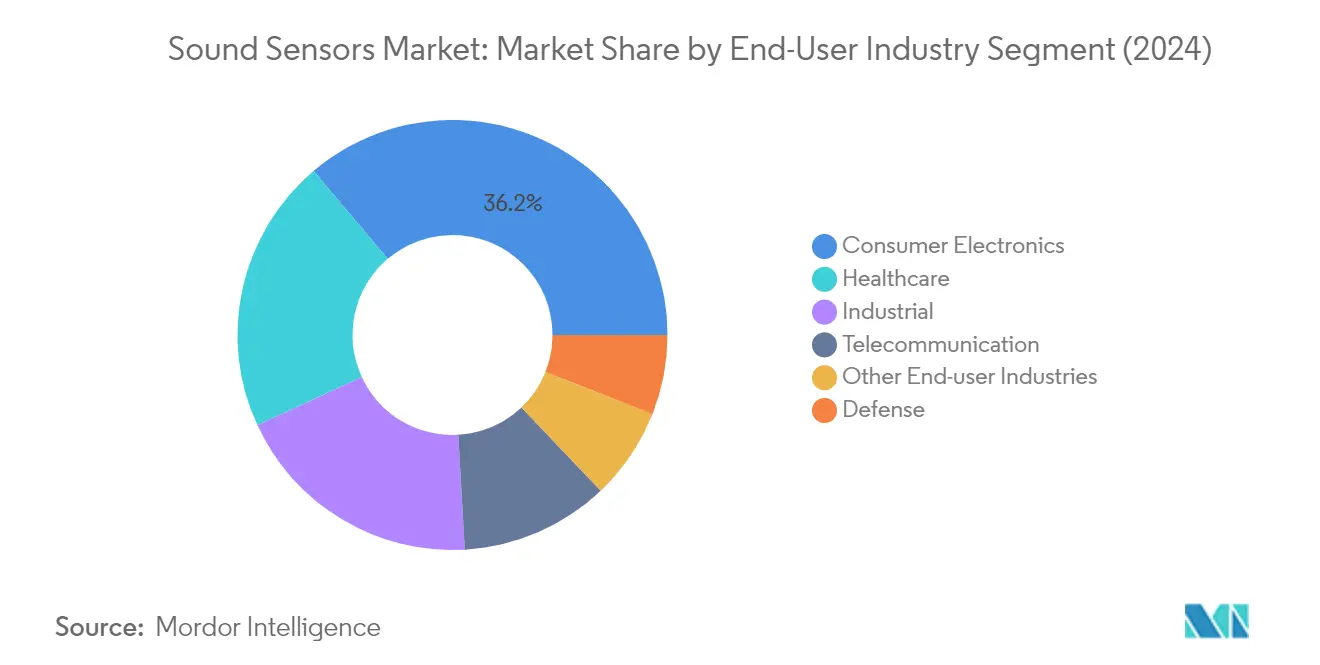
Industrial Segment in Sound Sensors Market
The industrial segment is projected to exhibit the highest growth rate of approximately 8% during the forecast period 2024-2029. This robust growth is attributed to the increasing adoption of acoustic sensors for monitoring machinery vibrations, analyzing acoustic emissions from equipment running at high speeds, and detecting fatigue failure in machine elements. The segment's growth is further propelled by the expanding implementation of Industry 4.0 practices and the rising use of robotics in manufacturing, stock management, and other industrial applications. Sound sensors are becoming increasingly crucial in industrial automation systems, enabling machines and robots to execute tasks according to specific parameters while ensuring enhanced safety protocols and operational efficiency under various environmental conditions.
Remaining Segments in End-User Industry
The healthcare segment maintains a significant presence in the market, with sound sensors being crucial for sleep monitoring devices, vital sign monitoring, and telemedicine applications. The telecommunications sector utilizes sound detection for voice-over-IP applications, speech recognition, and broadcast signals, while the defense segment employs these sensors for surveillance, reconnaissance, and perimeter security applications. The remaining end-user industries segment encompasses automotive applications for parking assistance and engine diagnostics, as well as entertainment applications for audio recording and gaming. Each of these segments contributes uniquely to the market's diversity and growth, driven by continuous technological advancements and expanding applications across various sectors.
Sound Sensors Market Geography Segment Analysis
Sound Sensors Market in North America
The North American sound sensors market maintains a significant position in the global landscape, commanding approximately 24% of the global market share in 2024. The region's market is primarily driven by substantial investments in defense technology and advanced manufacturing capabilities. The strong presence of major technology companies and continuous innovation in consumer electronics significantly contribute to market growth. The region's robust ecosystem for IoT devices and smart home technologies creates sustained demand for sound sensors across various applications. Additionally, the increasing adoption of industrial automation and Industry 4.0 practices has created new opportunities for sound sensor implementations in manufacturing and process control. The healthcare sector's digital transformation, particularly in telemedicine and remote patient monitoring, has also emerged as a key growth driver. Furthermore, the region's strong focus on research and development in acoustic measurement technology continues to drive innovation in sensor design and capabilities.
Sound Sensors Market in Europe
The European sound sensors market has demonstrated robust growth, with an estimated growth rate of around 7% during 2019-2024, driven by increasing industrial automation and smart manufacturing initiatives. The region's strong focus on Industry 4.0 implementation, particularly in countries like Germany and France, has created substantial opportunities for sound sensor applications. The European market benefits from stringent environmental and safety regulations that mandate the use of advanced monitoring systems across industries. The region's automotive sector, with its increasing focus on electric and autonomous vehicles, has emerged as a significant consumer of sound sensing technologies. The healthcare sector's modernization efforts and the growing adoption of smart healthcare devices have created additional demand streams. Moreover, the region's commitment to sustainable manufacturing practices and energy efficiency has led to increased adoption of sensor-based monitoring systems. The presence of established manufacturing facilities and research institutions continues to drive innovation in acoustic sensors market technologies.
Sound Sensors Market in Asia-Pacific
The Asia-Pacific sound sensors market is positioned for substantial expansion, with a projected growth rate of approximately 7% during 2024-2029. The region represents the largest market for sound sensors globally, driven by rapid industrialization and technological advancement in countries like China, Japan, and South Korea. The massive manufacturing base in the region, particularly in consumer electronics and automotive sectors, creates substantial demand for sound sensing technologies. The region's aggressive adoption of 5G technology and smart city initiatives has opened new avenues for sound sensor applications. The growing middle class and increasing consumer spending on smart devices and home automation systems further fuel market growth. The healthcare sector's modernization and the increasing adoption of telemedicine solutions have created additional demand streams. Furthermore, government initiatives supporting industrial automation and smart manufacturing have created a favorable environment for market expansion.
Sound Sensors Market in Rest of the World
The Rest of the World region, encompassing Latin America, the Middle East, and Africa, presents emerging opportunities in the sound sensors market. The region's growing focus on industrial modernization and infrastructure development creates new avenues for sound sensor applications. The increasing adoption of smart city initiatives and security systems, particularly in the Middle East, drives market growth. The region's expanding telecommunications infrastructure and growing smartphone penetration create additional demand for sound sensing technologies. The healthcare sector's modernization efforts and increasing adoption of digital health solutions contribute to market expansion. The defense sector's modernization initiatives, particularly in countries with significant military spending, create sustained demand for advanced sensing technologies. Furthermore, the region's growing focus on manufacturing sector development and industrial automation presents long-term growth opportunities for the acoustic sensors market.
Sound Sensors Market Overview
Top Companies in Sound Sensors Market
The sound sensors market features prominent players like Honeywell International, Omron Corporation, Rockwell Automation, Siemens AG, STMicroelectronics, Robert Bosch, Panasonic Corporation, and Bruel & Kjaer, who are driving innovation through continuous research and development investments. These companies are focusing on expanding their product portfolios through technological advancements in areas such as digital signal processing, automated devices with intelligent sound interpretation capabilities, and enhanced battery life for wireless applications. Strategic partnerships and collaborations have become increasingly important, with companies forming alliances to provide holistic management solutions for manufacturing facilities and other applications. Market leaders are also emphasizing operational agility through the development of compact, low-power systems that enable increased autonomy in machine-to-machine interactions and natural perceptual user interfaces for human-machine interactions. Geographic expansion, particularly in emerging markets, remains a key strategy as companies seek to capitalize on infrastructure investments and growing middle-class populations in developing regions.
Diverse Players Shape Market Competition Dynamics
The sound sensors market exhibits a moderately fragmented structure with a mix of global conglomerates and specialized manufacturers competing across various application segments. Large multinational corporations like Honeywell, Siemens, and Bosch leverage their extensive research capabilities, established distribution networks, and strong brand recognition to maintain their market positions. These companies benefit from their ability to offer comprehensive solutions across multiple industries, while specialized players like Bruel & Kjaer focus on developing expertise in specific applications such as acoustic measurement and analysis.
The market is characterized by ongoing consolidation through strategic acquisitions and partnerships, as companies seek to enhance their technological capabilities and expand their geographic presence. Major players are actively pursuing acquisitions of promising new entrants to consolidate their market positions and gain access to innovative technologies. The industry's competitive dynamics are further shaped by the presence of regional manufacturers who maintain strong positions in their local markets through customized solutions and established customer relationships, particularly in emerging economies where local market knowledge and presence are crucial for success.
Innovation and Adaptability Drive Market Success
Success in the sound sensors market increasingly depends on companies' ability to innovate while maintaining cost competitiveness and operational efficiency. Market leaders are investing heavily in research and development to develop advanced solutions that address evolving customer requirements across industries such as automotive, consumer electronics, industrial automation, and healthcare. Companies that can effectively integrate their sound sensor technologies with emerging trends like IoT, artificial intelligence, and smart home applications while maintaining competitive pricing are better positioned to capture market opportunities. The ability to provide comprehensive support services, including design assistance and post-installation support, has also become a crucial differentiator in the market.
For new entrants and smaller players, success lies in identifying and focusing on niche applications or regional markets where they can build specialized expertise and strong customer relationships. The relatively low threat of substitution for sound sensor technologies provides stability for market participants, though they must remain vigilant about potential technological disruptions. Companies must also navigate varying regulatory requirements across different regions and applications, particularly in sectors like healthcare and automotive where safety and performance standards are stringent. Building strong relationships with end-users and understanding their specific requirements remains crucial, as does the ability to adapt quickly to changing market conditions and technological advances. The integration of acoustic sensors and audio sensors in these applications further enhances the value proposition for companies operating in this space.
Sound Sensors Market Leaders
-
Honeywell International Inc.
-
Omron Corporation
-
Hunan Rika Electronic Tech Co. Ltd
-
Rockwell Automation Inc.
-
Siemens Ag
- *Disclaimer: Major Players sorted in no particular order
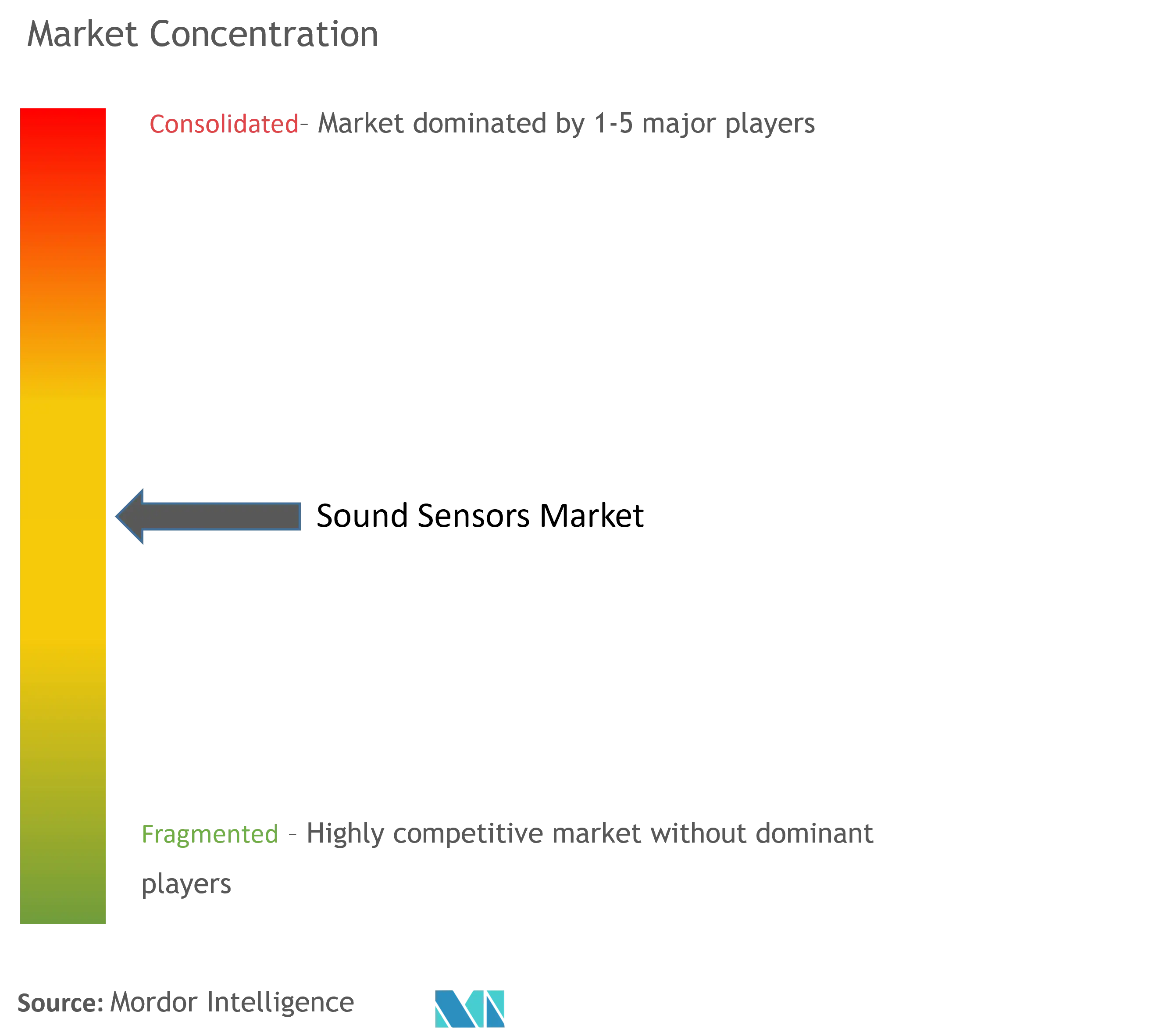
Sound Sensors Market News
- January 2024: Mercedes-AMG collaborated with the innovative artist will.i.am to unveil MBUX Sound Drive, a cutting-edge in-car audio technology designed to enhance the driving experience by immersing drivers in a virtual musical adventure. This innovative technology integrates the car's hardware with music software using specific 'in-car signals,' allowing the music to respond dynamically to the vehicle's performance characteristics in real-time.
- May 2023: Researchers from the Indian Institute of Technology Madras (IIT-M) and the Defence Research and Development Organization (DRDO) have developed cutting-edge underwater sensor technology to support the development of next-generation sonars for the Indian Navy. This indigenously developed technology focuses on piezoelectric MEMS (Micro Electro Mechanical Systems) processes, specifically producing high-performance thin films and converting piezo thin films into state-of-the-art naval sensors and devices for underwater applications.
Sound Sensors Market Report - Table of Contents
1. INTRODUCTION
- 1.1 Study Assumptions and Market Definitions
- 1.2 Scope of the Study
2. RESEARCH METHODOLOGY
3. EXECUTIVE SUMMARY
4. MARKET INSIGHTS
- 4.1 Market Overview
-
4.2 Industry Attractiveness - Porter's Five Forces Analysis
- 4.2.1 Bargaining Power of Suppliers
- 4.2.2 Bargaining Power of Buyers
- 4.2.3 Threat of New Entrants
- 4.2.4 Threat of Substitute
- 4.2.5 Intensity of Competitive Rivalry
5. MARKET DYNAMICS
-
5.1 Market Drivers
- 5.1.1 Technology Advancement in the Market, Leading to Increasing Adoption
- 5.1.2 Low Manufacturing Cost
-
5.2 Market Restraints
- 5.2.1 Emergence of Alternative Technologies
6. TECHNOLOGY SNAPSHOT
-
6.1 By Hydrophone
- 6.1.1 Omni-directional
- 6.1.2 Directional
-
6.2 By Microphone
- 6.2.1 Electret Microphones
- 6.2.2 Piezoelectric Microphones
- 6.2.3 Condenser Microphones
- 6.2.4 Dynamic/Magnetic Microphones
- 6.2.5 Other Microphones
7. MARKET SEGMENTATION
-
7.1 By End-user Industry
- 7.1.1 Consumer Electronics
- 7.1.2 Telecommunications
- 7.1.3 Industrial
- 7.1.4 Defense
- 7.1.5 Healthcare
- 7.1.6 Other End-user Industries
-
7.2 By Geography***
- 7.2.1 North America
- 7.2.2 Europe
- 7.2.3 Asia
- 7.2.4 Australia and New Zealand
- 7.2.5 Latin America
- 7.2.6 Middle East and Africa
8. COMPETITIVE LANDSCAPE
-
8.1 Company Profiles*
- 8.1.1 Honeywell International Inc.
- 8.1.2 Omron Corporation
- 8.1.3 Hunan Rika Electronic Tech Co. Ltd
- 8.1.4 Rockwell Automation Inc.
- 8.1.5 Siemens AG
- 8.1.6 Stmicroelectronics NV
- 8.1.7 Robert Bosch Gmbh
- 8.1.8 Panasonic Corporation
- 8.1.9 Bruel And Kjaer
- 8.1.10 Teledyne Technologies Incorporated
9. INVESTMENT ANALYSIS
10. MARKET OPPORTUNITIES AND FUTURE TRENDS
Sound Sensors Market Industry Segmentation
A sound sensor is a component/module that converts sound into a physical quantity to be measured into a signal that can be displayed, read, stored, or used to control some other amount. Sound sensors can be used to measure sound levels over a wide range of frequencies. They find applications in detecting weak signals, broadband signals, pipeline leaks, and tracking sound sources. Sound sensors also find underwater applications and can be used in the air to detect acoustic emissions and ultrasonic sounds.
The sound sensors market is segmented by end-user industry (consumer electronics, telecommunications, industrial, defense, healthcare, and other end-user industries) and geography (North America, Europe, Asia Pacific, and the Rest of the World). The market sizes and forecasts are in terms of value (USD) for all the above segments.
| By End-user Industry | Consumer Electronics |
| Telecommunications | |
| Industrial | |
| Defense | |
| Healthcare | |
| Other End-user Industries | |
| By Geography*** | North America |
| Europe | |
| Asia | |
| Australia and New Zealand | |
| Latin America | |
| Middle East and Africa |
Sound Sensors Market Research FAQs
How big is the Sound Sensors Market?
The Sound Sensors Market size is expected to reach USD 1.23 billion in 2025 and grow at a CAGR of 6.08% to reach USD 1.65 billion by 2030.
What is the current Sound Sensors Market size?
In 2025, the Sound Sensors Market size is expected to reach USD 1.23 billion.
Who are the key players in Sound Sensors Market?
Honeywell International Inc., Omron Corporation, Hunan Rika Electronic Tech Co. Ltd, Rockwell Automation Inc. and Siemens Ag are the major companies operating in the Sound Sensors Market.
Which is the fastest growing region in Sound Sensors Market?
Europe is estimated to grow at the highest CAGR over the forecast period (2025-2030).
Which region has the biggest share in Sound Sensors Market?
In 2025, the Asia Pacific accounts for the largest market share in Sound Sensors Market.
What years does this Sound Sensors Market cover, and what was the market size in 2024?
In 2024, the Sound Sensors Market size was estimated at USD 1.16 billion. The report covers the Sound Sensors Market historical market size for years: 2019, 2020, 2021, 2022, 2023 and 2024. The report also forecasts the Sound Sensors Market size for years: 2025, 2026, 2027, 2028, 2029 and 2030.
Our Best Selling Reports
Sound Sensors Market Research
Mordor Intelligence provides comprehensive industry analysis and market insights for the sound sensors market, covering crucial aspects such as market size, growth trends, and competitive landscape. Our research encompasses various segments including acoustic sensors, ultrasonic sensors, MEMS microphones, and audio equipment applications across different industries. The report pdf delivers detailed market forecasts, technological innovations, and strategic developments, helping stakeholders make informed decisions in the rapidly evolving acoustic sensors industry.
Our consulting expertise extends beyond traditional market research to provide actionable intelligence in the sound detection and audio monitoring space. We assist clients with technology scouting to identify cutting-edge developments in acoustic measurement and voice recognition sensors, conduct comprehensive competition assessments, and support new product launch strategies. Our team specializes in analyzing customer needs and behavior patterns specific to audio sensors & transducers, helping businesses optimize their product development and market positioning. Through advanced data analytics and visualization techniques, we provide insights into emerging applications and market opportunities in the sound sensors ecosystem.

